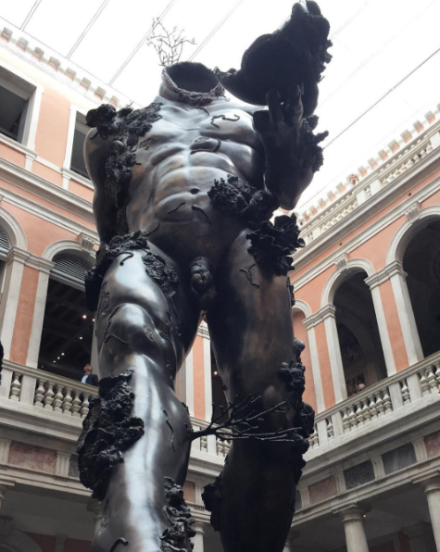
Damien Hirst, Treasures from the Wreck of the Unbelievable (Installation View), via Art Observed
After much anticipation, the crowds of the Venice Biennale have finally packed through the doors of the Palazzo Grassi and Punta Della Dogana to take their turn at the visual tour de force of Damien Hirst’s Treasures of the Wreck of the Unbelievable. The show, which opened last month at François Pinault’s pair of exhibition spaces in the city, has garnered considerable discussion over the past several months since its announcement, and with good reason. Hirst’s exhibition is a challenging, and often confounding experience, taking on the museum as a form, and pushing it to its symbolic limits.

Damien Hirst, Treasures from the Wreck of the Unbelievable (Installation View), via Art Observed
By now, the concept and theme has been explained ad infinitum: Hirst created near countless works in gold and bronze, then buried them at sea, simulating the recovery of an ancient shipwreck and the restoration of its plunder. Spread throughout the pair of exhibitions are an impression collection of objects; gold doubloons, statues, busts, and other works running through the range of human history, all said to come from the collection of a single freed slave whose ship, The Unbelievable sunk in the Indian Ocean, and whose treasure was lost to the sands of time. Demon with Bowl, one of the hallmarks of the show, is a particularly intriguing example, a massive sculpture recast from a smaller original, and bearing all of the marks of a considerable time period underwater, with points of decay and ample evidence of clinging sea life across its surface.
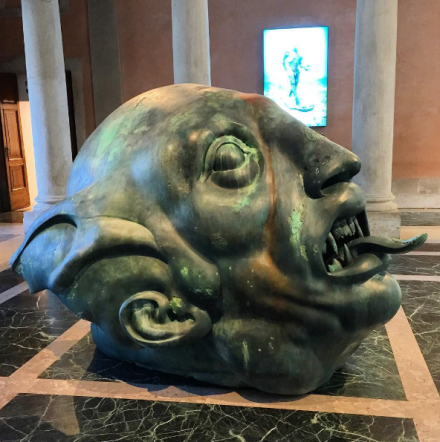
Damien Hirst, Treasures from the Wreck of the Unbelievable (Installation View), via Art Observed

Damien Hirst, Treasures from the Wreck of the Unbelievable (Installation View), via Art Observed
Yet in execution, the works seem to push and pull at this concept, constantly disrupting and reworking this legend’s limits in a manner that often pushes it well beyond the believable. Hirst’s work in the exhibition is nothing if not expansive, his riffs and improvisations on the theme running the full length of human history, often with considerable overlaps and hybrids in cultural history. One piece at the Punta Della Dogana, Cronos Devouring his Children takes the Greek legend and twists it through the lens of modernity, giving it a hyper-graphic, extremely disturbing form that confuses and clouds its initial touchstones. In other works, the artist has crafted Egyptian pharaohs and gods from the likenesses of modern celebrities, including one work that bears a striking resemblance to musician Pharrell Williams. In another room, a Mickey Mouse statue is coated in urchins and coral, twisting the time limits and concepts of his work towards the breaking point. At the same time, the tension wrought from the work’s intense attention to simulation is considerable, a point that, based on the subject matter, seems meticulously planned by the artist.
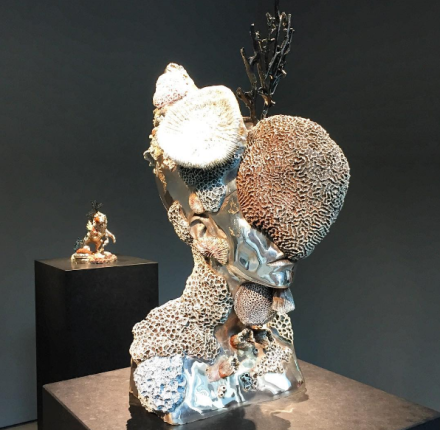
Damien Hirst, Treasures from the Wreck of the Unbelievable (Installation View), via Art Observed
By this reading, Hirst’s work in the show seems particularly invested in challenging both the iconography and integrity of the museum in the modern era, allowing this sort of blending of forms and histories in a manner that takes the museum as a site of history head-on. A particularly strong touch comes from the artist’s mounted texts included with each piece, which reference forgotten periods of history, or speculate on the histories of the objects exhibited. In one particularly comical addition, he places a series of sculpted torsos in an image alongside the works of Joan Miró and the surrealists, a twofold play on his imagery that makes its critique of the institution, and its claim to total historical authenticity, as increasingly potent. The entire concept of the show, down to the self-parodying statement that hangs over the entrance to the Punta Della Dogana (“somewhere between lies and truth lies the truth”), seems distinctly targeted to break down readings of the museum as a site of truth, and leave only its position as a site of power. As many will point out, the hard dollar value on both the production and sale of these pieces is not insignificant to the work itself, and the intense scale of work on view only serves to underscore both Hirst’s conceptual project and the fiscal power he still seems to wield in situations such as this one.
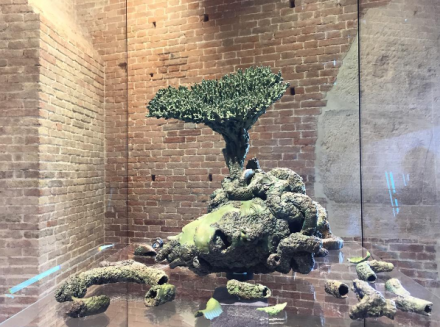
Damien Hirst, Treasures from the Wreck of the Unbelievable (Installation View), via Art Observed

Damien Hirst, Treasures from the Wreck of the Unbelievable (Installation View), via Art Observed
As some have playfully termed it, the exhibition could be seen as the first blockbuster of the “Fake News” era, a show where simulation and signifiers are under constant states of negotiation and conflict. In Hirst’s work, the museum itself becomes the battleground, where each of these elements is forced into combat, much like the mythological conflicts he spotlights in so many of his works on view. Unlike his chosen legends, however, a winner may be hard to identify, but that certainly doesn’t make the fight any less compelling.
The exhibition is on view through December 3rd.
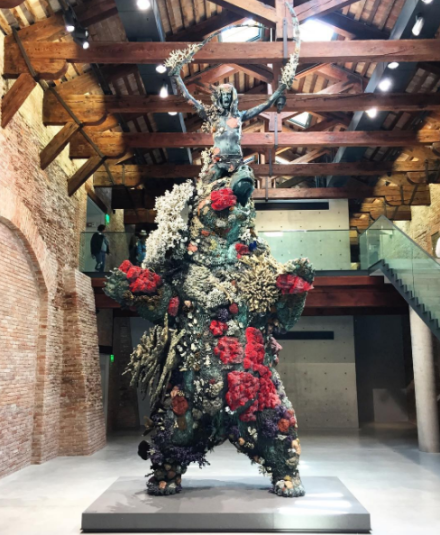
Damien Hirst, Treasures from the Wreck of the Unbelievable (Installation View), via Art Observed

Damien Hirst, Treasures from the Wreck of the Unbelievable (Installation View), via Art Observed

Damien Hirst, Treasures from the Wreck of the Unbelievable (Installation View), via Art Observed
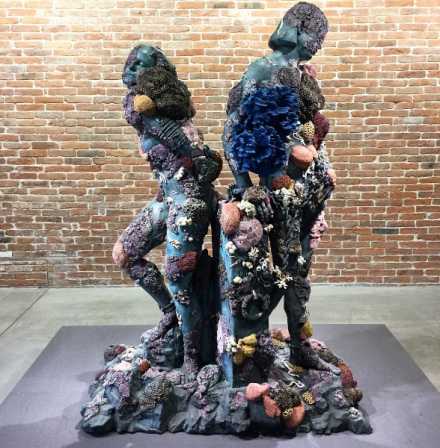
Damien Hirst, Treasures from the Wreck of the Unbelievable (Installation View), via Art Observed
— D. Creahan
Read more:
Palazzo Grassi [Exhibition Site]
Damien Hirst, Treasures from the Wreck of the Unbelievable [Telegraph]
What Damien Hirst did next [FT]



